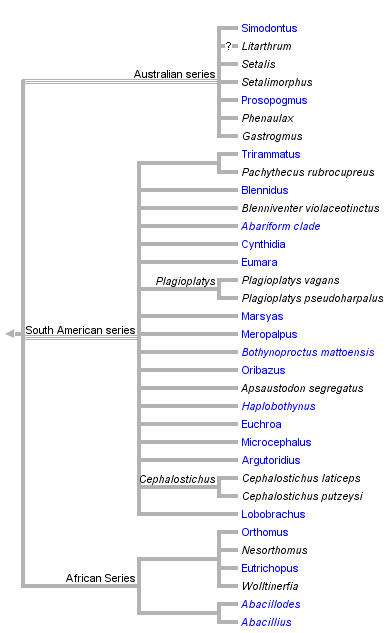Euchroina
Kipling Will


This tree diagram shows the relationships between several groups of organisms.
The root of the current tree connects the organisms featured in this tree to their containing group and the rest of the Tree of Life. The basal branching point in the tree represents the ancestor of the other groups in the tree. This ancestor diversified over time into several descendent subgroups, which are represented as internal nodes and terminal taxa to the right.

You can click on the root to travel down the Tree of Life all the way to the root of all Life, and you can click on the names of descendent subgroups to travel up the Tree of Life all the way to individual species.
For more information on ToL tree formatting, please see Interpreting the Tree or Classification. To learn more about phylogenetic trees, please visit our Phylogenetic Biology pages.
close boxIntroduction
The Euchroina are distributed in all the southern continents with greatest known diversity in South America. The group is composed of an Australian series (=Setalis series of Moore (1965)), Euchroa and Blennidus-like taxa in the South and Central American series (one genus, Abaris, reaches southern North America) and a few taxa from Africa and Southern Europe.
Characteristics
They are medium to small sized for pterostichines, frequently metallic bronze, green or purple colored. Likely synapomorphies for the group included the lack the coronal suture in larvae (the few that are known), adults with well impressed frontal furrows on the head and a pecular "goose-neck" form of the female reproductive tract (Will 2000). Additionally, most species have sulci on the abdominal sterna, arcuate anterior marginal sulcus on the metacoxae and prominent eyes.
Discussion of Phylogenetic Relationships
The arrangement of taxa in series as presented here is only a working hypothesis. African and Australian taxa do seem group as within-continent groups and appear most similar among themselves. However, they are likely clades or even grades within the group presently desinated as the South American series.
Title Illustrations

| Scientific Name | Abaris aenea |
|---|---|
| Identified By | K.Will |
| Life Cycle Stage | Adult |
| Body Part | Habitus |
| View | Dorsal |
| Image Use |
 This media file is licensed under the Creative Commons Attribution License - Version 3.0. This media file is licensed under the Creative Commons Attribution License - Version 3.0.
|
| Copyright |
© Kipling Will

|
| Scientific Name | Tichonilla nigra |
|---|---|
| Identified By | K.Will |
| Life Cycle Stage | Adult |
| Image Use |
 This media file is licensed under the Creative Commons Attribution License - Version 3.0. This media file is licensed under the Creative Commons Attribution License - Version 3.0.
|
| Copyright |
© Kipling Will

|
| Scientific Name | Oribazus catenulatus |
|---|---|
| Specimen Condition | Dead Specimen |
| Identified By | K.Will |
| Life Cycle Stage | Adult |
| Image Use |
 This media file is licensed under the Creative Commons Attribution License - Version 3.0. This media file is licensed under the Creative Commons Attribution License - Version 3.0.
|
| Copyright |
© Kipling Will

|
About This Page
Kipling Will

University of California, Berkeley, California, USA
Correspondence regarding this page should be directed to Kipling Will at
Page copyright © 2005 Kipling Will
 Page: Tree of Life
Euchroina.
Authored by
Kipling Will.
The TEXT of this page is licensed under the
Creative Commons Attribution License - Version 3.0. Note that images and other media
featured on this page are each governed by their own license, and they may or may not be available
for reuse. Click on an image or a media link to access the media data window, which provides the
relevant licensing information. For the general terms and conditions of ToL material reuse and
redistribution, please see the Tree of Life Copyright
Policies.
Page: Tree of Life
Euchroina.
Authored by
Kipling Will.
The TEXT of this page is licensed under the
Creative Commons Attribution License - Version 3.0. Note that images and other media
featured on this page are each governed by their own license, and they may or may not be available
for reuse. Click on an image or a media link to access the media data window, which provides the
relevant licensing information. For the general terms and conditions of ToL material reuse and
redistribution, please see the Tree of Life Copyright
Policies.
- First online 07 July 2006
- Content changed 21 October 2006
Citing this page:
Will, Kipling. 2006. Euchroina. Version 21 October 2006 (temporary). http://tolweb.org/Euchroina/51298/2006.10.21 in The Tree of Life Web Project, http://tolweb.org/











 Go to quick links
Go to quick search
Go to navigation for this section of the ToL site
Go to detailed links for the ToL site
Go to quick links
Go to quick search
Go to navigation for this section of the ToL site
Go to detailed links for the ToL site